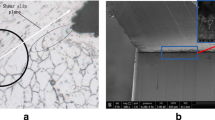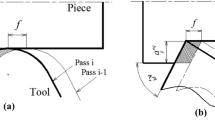Abstract
The cutting force modeling is crucial for analyzing and understanding internal mechanism of machining process. In this paper, an oblique model considering the fracture toughness and thermo-mechanical properties is presented. The fracture toughness is introduced to describe the power spent in the formation of the new surfaces. Meanwhile, a modified partition factor model which integrates the Weiner’s partition analysis and Jaeger’s friction slider solution is proposed to describe the fraction of the shear plane energy conducted back into the chip so as to calculate the temperature at the shear plane accurately. To testify the correctness of the proposed model, 27 cutting data are carried out within a wide range of cutting conditions. The results show that the proposed model can reflect the mechanistic characteristics of the machining process accurately and agree fairly well with experimental measurements.
Similar content being viewed by others
References
Astakhov VP, Outeiro JC (2008) Metal cutting mechanics, finite element modeling. Springer, London
Chern GL (2005) Study on a new turning method to simulate orthogonal cutting and to verify an edge breakout model. Int J Adv Manuf Technol 26:965–969
Tounsi N, Vincenti J, Otho A, Elbestawi MA (2002) From the basic mechanics of orthogonal metal cutting toward the identification of the constitutive equation. Int J Mach Tools Manuf 42:1373–1383
Markopoulos AP (2013) Cutting mechanics and analytical modeling. Springer Briefs in Applied Sciences and Technology 11–27
Usui E, Hirota A (1978) Analytical prediction of three dimensional cutting process—Parts 2: chip formation and cutting force with conventional single-point tool. J Manuf Sci Eng 100(2):229–235
Astakhov VP (2006) Tribology of metal cutting. Elsevier, London
Usui E, Hirota A, Masuko M (1978) Analytical prediction of three dimensional cutting process—Part 1: basic cutting model and energy approach. J Manuf Sci Eng 100(2):222–228
Finnie I (1956) Review of the metal cutting theories of the past hundred years. Mech Eng 78:715–721
Atkins AG (2003) Modeling metal cutting using modern ductile fracture mechanics: quantitative explanations for some longstanding problems. Int J Mech Sci 45:373–396
Atkins AG (1974) Fracture toughness and cutting. Int J Prod Res 12(2):263–274
Orowan E (1950) Fatigue and fracture in metals. Wiley, New York
Marusich TD, Ortiz M (1995) Modeling and simulation of high speed machining. Int J Numer Methods Eng 38:3675–3694
Lin CR, Guo YB (2000) Finite element analysis of the effect of sequential cuts and tool-chip friction on residual stresses in a machined layer. Int J Mech Sci 42:1069–1086
Loewen EG, Shaw MC (1954) On the analysis of cutting tool temperatures. Trans ASME 76:217–231
Wright PK, McCormick SP, Miller TR (1980) Effect of rake face design on cutting tool temperature distributions. J Manuf Sci Eng 102:123–128
Jaspers, Serge, PFC (1999) Metal cutting mechanics and material behavior. PhD Thesis, Technische Universiteit Eindhoven
Li SJ, Zhou YF, Jin RC, Ji Z (2001) Dynamic force modelling for a ball-end milling cutter based on the Merchant oblique theory. Int J Adv Manuf Technol 17:477–483
Merchant ME (1945) Mechanics of the metal cutting process. J Appl Phys 16:267–275
Pawade RS, Sonawane HA, Joshi SS (2009) An analytic model to predict specific shear energy in high-speed turning of Inconel 718. Int J Mach Tools Manuf 49:979–990
Dandekar CR, Shin YC (2012) Modeling of machining of composite materials: a review. Int J Mach Tools Manuf 57:102–121
Gu LY, Wang MJ (2013) Experimental and theoretical research on critical characteristics for adiabatic shear localization fracture in high-speed machining. Int J Adv Manuf Technol 68:1231–1240
Zhou FJ (2014) A new analytical tool-chip friction model in fry cutting. Int J Adv Manuf Technol 70:309–319
Kececioglu D (1958) Shear strain rate in metal cutting and its effect on shear flow stress. J Eng Ind Trans ASME 80:158
Moufki A, Devillez A, Dudzinski D, Molinari A (2004) Thermo-mechanical modeling of oblique cutting and experimental validation. Int J Mach Tools Manuf 44:971–989
Li BL, Wang XL, Hu YJ, Li CG (2011) Analytical prediction of cutting forces in orthogonal cutting using unequal division shear zone model. Int J Adv Manuf Technol 54:431–443
Shaw MC (1984) Metal cutting principles. Oxford Science, Oxford
Jaeger JC (1943) Moving source of heat and the temperature at sliding contacts. J Proc R Soc NSW 76:203–224
Weiner JH (1955) Shear plane temperature distribution in orthogonal cutting. Trans ASME 77:1331–1341
Author information
Authors and Affiliations
Corresponding author
Rights and permissions
About this article
Cite this article
Liu, C., Wang, G., Ren, C. et al. Mechanistic modeling of oblique cutting considering fracture toughness and thermo-mechanical properties. Int J Adv Manuf Technol 74, 1459–1468 (2014). https://doi.org/10.1007/s00170-014-6100-4
Received:
Accepted:
Published:
Issue Date:
DOI: https://doi.org/10.1007/s00170-014-6100-4




